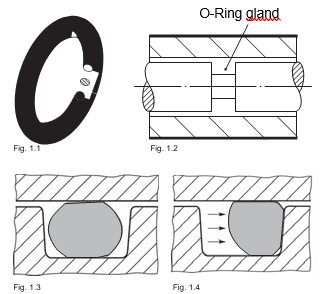An O-ring seal is a means to prevent the loss of a fluid or gas. The seal consists of an O-ring and a metal gland. An O-ring is a circular ring with a circular cross-section moulded from rubber. The gland -usually made from metal -houses the O-ring. The combining of these elements – O-ring and gland – produce the O-ring Seal.
O-ring seals which are effective against fluids or gases are characterised by a lack of leakage. This “no tolerance” can be achieved in different ways; by welding, soldering, brazing, lapped surfaces, or the yielding of a softer material which is partially or held between two harder stiffer elements. The O-ring Seal belongs to this latter class. Rubber (or for that matter plastic material) can be viewed as a non-compressible, viscose fluid with very high surface tension. Because of the O-ring resilience to compression and system pressure (fig. 1.4), a seal is effected.

A static seal is defined as a seal in which all the adjacent surfaces do not move relative to each other (except for small movements due to fluid pressure).
Examples of static seals are:
The seal under a bolt head or rivet, the seal in a pipe connection, the seal under a lid or plug. It is said of an O-ring “it is the best static seal ever developed”. Perhaps the main strength for this claim is that the O-ring is “foolproof”. No retightening is required and the human error factor does not exist if the O-ring is fitted in the correct application, in original equipment or during overhaul. The O-ring requires no high loading torque to obtain a leak-free seal. Further detailed information can be taken from section 2.2.
The parts to be sealed move relative to each other in a reciprocating motion. With this motion, the O-ring is displaced. O-rings on pistons or rods in hydraulic cylinders produce dynamic seals. O-rings are most effective when used for short strokes with relatively small diameters. Millions of O-rings are successfully used as dynamic seals in hydraulic or other fluids, or even in compressed air. Correctly applied, their life-span can be that of the equipment in which they are installed. Dynamic seals are influenced by extrusion, respiration, surface finish and hardness of the seal material. These factors must be taken into consideration during the design process.Further detailed information can be taken from section 2.4.
When choosing an O-ring compound, many factors must be taken into account. The medium to be sealed, pressure and temperature range are the main factors to be considered. A compound which is optimally suited for steam can be negatively influenced by alcohol or antifreeze in a water cooling system. A compound which is compatible with liquid oxygen at low temperatures can be unsuitable at high temperatures, e.g. in air heaters. All these examples show that the O-ring compound should be chosen according to the specific application. Based on the numerous requirements made on an O-ring, the final choice of a compound is at best an optimal compromise. To this end, Parker offers O-ring compounds for virtually every application, including military and aerospace. Further detailed information can be taken from section 5.
This PC program for calculation and selection of o-rings has been designed specifically for application engineering users. For many years Parker’s O-Ring Handbook has been a frequently used tool for selecting o-rings and compounds. Although this publication provides all essential information, a thorough knowledge base is needed to use this tool correctly. Before the introduction of “inPHorm” design engineers had to work their way through calculations of tolerance limits and pore over lists of dimensions and tables before being able to select the o-ring best suiting their needs.
Thanks to “inform” this is now a thing of the past, at least for the preponderance of o-ring sealing applications. “inPHorm” takes you through the selection process by systematically working- ing out the various process steps involved in your application. Lengthy calculations and searching through tables are now performed in a matter of seconds.
Within a few minutes, design engineers can determine the correct dimensions of the groove and seal as well as the suitable compound. Just open “inPHorm” ...click on “Parameters” ... and the right selection of o-rings will appear on your screen.
If approximate groove dimensions are known for new engineering designs, developers can optimise the design criteria themselves by entering different groove geometries, i.e. friction can be optimised by reducing compression up to the permissible limit. This eliminates the need to perform tedious calculations of all tolerance limits and leafing through lists of dimensions and media resistance tables as well as the potential for error. If check as to whether or not an existing o-ring seal design works best is extremely easy as well: just key in the data and “inform” will immediately display the optimum solution.